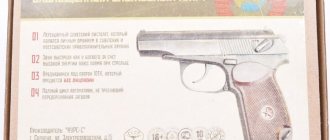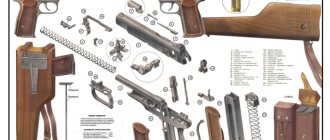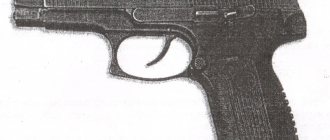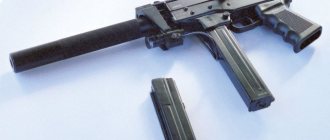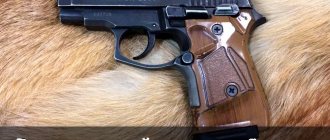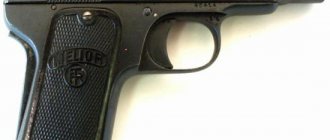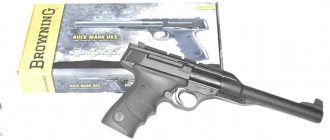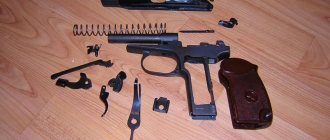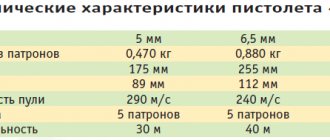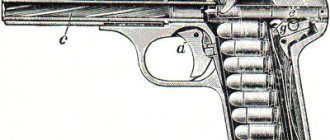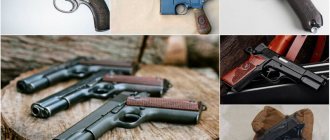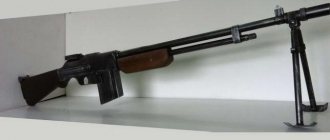FN Browning M1910 and M1922 pistols
The FN Browning Model 1910 is a self-loading pistol designed by John Browning, developed as an improved version of the FN Browning M1900 .
History of creation and production
The pistol was developed for the Belgian company Fabrique Nationale (FN) and the Colt company. The latter showed no interest in this model, and production was concentrated in Belgium. Initially, the Model 1910 was chambered in 7.65x17mm Browning, and from 1912, in 9x17mm Short.
In 1922, by order of the Kingdom of Serbs, Croats and Slovenes, a new version of the Model 1910 was released with a longer barrel and a handle that accommodated a larger capacity magazine, called FN Browning M1922 . Its magazine held 9 rounds of 7.65x17 mm or 8 rounds of 9x17 mm. The Model 1922 was in service in the armies of several European countries.
During the Second World War, the production of FN Browning M1922 pistols continued, but for the Germans, who used them as weapons of a limited standard. During the occupation, Belgian gunsmiths produced 363,000 M1922 pistols for the Wehrmacht, 7.65 mm caliber, known as Pistole 626(b) and 9 mm caliber, Pistole 641(b) .
Design and principle of operation
Automatic pistols work by using the recoil energy of a free bolt. The barrel bore is locked by the bolt casing and the compression force of the return spring placed around the barrel (for the first time in a mass-produced pistol), due to which the dimensions of the bolt casing and the weapon as a whole have been significantly reduced. Subsequently, this solution, which reduced the number of parts and dimensions of the pistol, was used in pistols of other systems. At the same time, the disadvantage of this scheme is the overheating of the return spring during prolonged and high-speed shooting, the loss of its mechanical qualities, as a result of which the operation of the automation may be disrupted. But for a pocket pistol not intended for long-term combat, this is unimportant.
The trigger mechanism is striker-fired, single-action, with three safeties - a magazine safety, an automatic one on the back of the handle (turns off when the hand grips the handle correctly) and a manual safety on the left side of the frame, blocking the trigger and the bolt.
Partial disassembly of the FN Browning M1910 pistol
The single-stack magazine is held in place by a latch located at the bottom of the handle. The sighting devices of the 1910 model are a longitudinal groove running along the upper edge of the shutter-casing, inside of which a semicircular front sight is located at the front.
The Model 1922 features a protruding, extended barrel and a grip that accommodates a larger capacity magazine. The sights are open and non-adjustable.
Different types of holsters for FN Browning M1910 and M1922 pistols
Operation and combat use
Both versions of the pistol were widely used as civilian, police and military weapons, and were very popular in Europe until the end of World War II and even after, and their production continued until 1983 in various versions, including with adjustable sights.
- Belgium - in service with the police and army.
- Greece - in 1926–1929. 9,980 units purchased. 9mm FN Browning M1922 pistols for the army.
- Denmark - adopted before the outbreak of World War II
- Netherlands - in October 1924, the 7.65 mm pistol was adopted for service under the name Pistool M25 No.1 .
- Spain - after the outbreak of the war in Spain in 1936, 200 pcs. 9-mm FN Browning M1922 pistols were purchased by the government of the Spanish Republic.
- Yugoslavia - in February 1923, 60 thousand 9-mm model 1922 pistols were ordered, and additional quantities were subsequently ordered.
It was from the 9-mm FN Browning M1910 pistol No. 19074 that Gavrilo Princip killed Archduke Ferdinand and his wife in Sarajevo in June 1914. The murder became the reason for the First World War. Pistol No. 19074, legally purchased in Belgrade along with three other similar Brownings for the Black Hand organization, is kept in the Vienna Military History Museum.
- Third Reich - used during World War II; captured Belgian 7.65 mm FN Browning M1910 pistols entered service under the name Pistole 621(b) ; Belgian 7.65 mm pistols FN Browning M1922 - under the name Pistole 626(b) ; Danish 7.65 mm pistols FN Browning M1922 - under the name Pistole 626(d) ; Belgian 9-mm pistols FN Browning M1922 - under the name Pistole 641(b) ; Yugoslav 9-mm pistols FN Browning M1922 - under the name Pistole 641(j).
History of the creation of Browning pistols
Browning John Moses began his career in his homeland, the USA, but the Browning pistol, which brought eternal glory to the inventor, was patented (FN), registered in Belgium. It became the first and largest Browning manufacturer in Europe.
It was Mr. Browning who was the author of the automatic operation schemes that formed the basis of self-loading pistols and continue to be used in the new millennium:
- using the recoil of the barrel during a short stroke and locking the bolt by tilting or turning the barrel;
- using blowback recoil;
- using the removal of powder gases.
Based on the first two schemes, the designer personally created pistol models that were put into mass production and gained enormous popularity. At one time, all portable multi-shot pistols were called “Brownings” in Russia, just as any revolvers were called “revolvers.”
The designer began developing a self-loading pistol in 1895, and two years later filed a patent for this invention. When creating the classic model, the inventor used a blowback shutter circuit.
In 1898, he first presented a pistol of his own design, and the aforementioned Belgian company undertook to produce it, which managed to produce 3,000 copies. In 1900, an improved design appeared, which is called the Browning M1900.
FN Browning M1910 pistol
There is a very wise expression that it is not a gun that shoots, but a person, however, despite this, the weapon from which high-profile murders were committed has always aroused interest among ordinary people, unless of course it is some type of weapon widespread in a certain territory, for example, like a PM or TT in the countries of the former Soviet Union. However, much more interesting is the weapon, the shot from which actually starts wars, so the most striking example of such a weapon is the FN Browning M1910, the shot from which caused the start of the First World War. But history is history, and now let’s try to figure out what kind of weapon it was, how widespread it was, and what features of the FN Browning M1910 pistol have migrated to modern models of short-barreled weapons.
The appearance of the FN Browning M1910 pistol includes many elements already familiar from other younger models, or it would be more accurate to say that many elements of this pistol were used in other later models of weapons of various origins. Even the shape of the bolt casing is similar in many ways to the well-known Makarov pistol. However, it cannot be said that the FN Browning M1910 pistol was copied by someone completely; models more or less similar to this weapon can only be called the FN Browning M1922, which is a development of this model. The FN Browning M1910 pistol is a relatively compact model, but it cannot be called a “pocket” pistol. From previous models of Browning pistols, many already known elements migrated to it, such as an automatic safety in the form of a button on the back of the weapon’s handle or the barrel mounting design. There are a lot of innovations in this pistol, but more on all of that below. If we consider Browning pistols sequentially from earlier to later, we cannot help but notice that, with all their diversity, individual elements of the weapon are repeated, but at the same time, some components can change radically, which indicates the desire to create an almost ideal weapon in which all the best solutions tested on other models. Whether it was possible to do this or not is difficult to answer, since a weapon ideally suited for one task will behave less effectively in other conditions, which is why apparently there is still no one ideal pistol for any combat mission. However, the development of weapons is observed and it is impossible not to note, first of all, that each new pistol becomes simpler than the previous model, both in production and in maintenance.
The FN Browning M1910 pistol itself replaced the discontinued FN Browning M1900 pistol, with a design that was quite unusual both for modern weapons and for weapons of that time. At the same time, one cannot fail to note the technical solutions that were also new in this model. Thus, the main difference between the FN Browning M1910 pistol and other models, as once in the FN Browning M1900 pistol, which it replaced, the main feature was the return spring of the weapon. True, if in the 1900 model the location and functions of the return spring were indeed unusual even for modern weapons, then the return spring of the FN Browning M1910 will most likely not cause any emotions in anyone now, since its same arrangement is used in many well-known models of pistols. The fact is that the return spring of the FN Browning M1910 pistol is located around the barrel of the weapon, and this technical solution was used for the first time at that time. This arrangement of the return spring, first of all, significantly reduced the dimensions of the pistol and weight; in addition, in production such weapons were also, albeit slightly, cheaper, which can also be identified as a separate plus. Thus, from the heights of modern times, we can safely say that Browning is related to at least half of modern weapon models around the world, since no one had used such a solution before him.
Description of the Brauning FN 1910-O pistol, cooled by SHP (Russian arms company, 7.65 mm)
The modern and elegant model of the Brauning 1910 combat pistol has enjoyed and continues to enjoy great success among the Belgian special forces.
This love is justified primarily by its relatively small dimensions, where the length is only 153 mm and the weight does not exceed 0.6 kg. The presented Browning FN 1910-O pistol, cooled by SHP, underwent a complete rework at the Russian Arms Company plant, after which firing with live ammunition became completely impossible. To fire the SHP Brauning FN 1910-O pistol, you now need blank cartridges with a caliber of 7.65 mm . The principle is that after pressing the trigger, a loud bang occurs and a fairly strong flame bursts out of the barrel. Thanks to this, a shot from a military weapon is completely simulated.
In order not to injure surrounding people or pets during the shooting process, the manufacturer recommends not pointing the Browning FN 1910-O pistol at the face. And among other things, to increase protection against an unintentional shot, this model is additionally equipped with a special non-automatic fuse.
Despite all the manipulations carried out when deactivating the model, you can buy a cooled Brauning FN 1910-O SHP by ordering it to your home in any city in Russia.
The barrel with internal mechanisms is completely made of high-quality alloy steel made in Belgium, and further special coating will help protect the elements from rust. Another argument in favor of choosing the Browning FN 1910-O pistol is firing in semi-automatic mode, which sufficiently increases the speed when firing shots. The magazine holds 6 rounds, so it is multi-charged.
In the manufacture of the body of the Brauning FN 1910-O cold pistol, high-quality metal is used, covered with bluing to protect against rust. The only part that does not involve metal is the plastic pistol grip. In addition, there are special notches on its body for more comfortable use of the model.
And although the model is a Belgian brand, the price of the Browning FN 1910-O cooled pistol will please the eye of any buyer.
This model is perfect for shooting most movies, especially action films, and it will also be of interest to many collectors and take pride of place in their collection.
